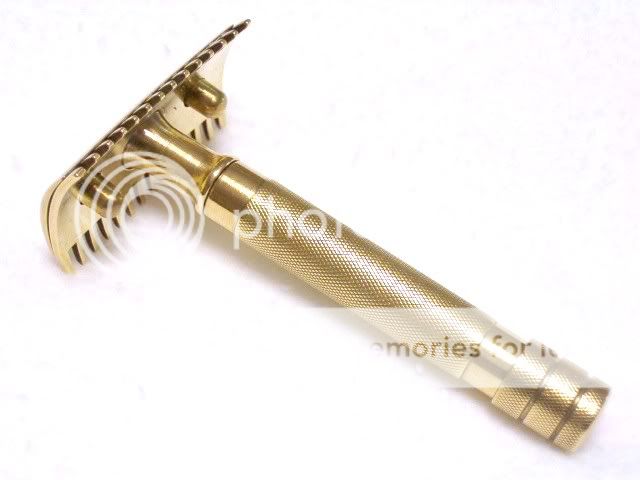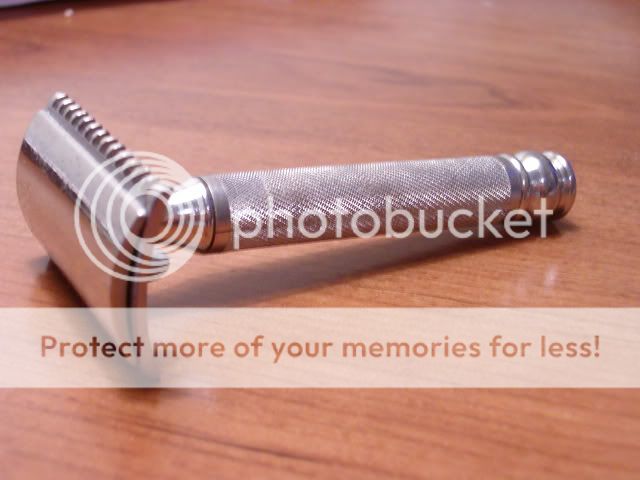I have heard the mention of "Gillette clones" quite a bit recently. In most cases the term is not used correctly. Over the years there have been hundreds of double edge razors manufactured. There are only so many different ways to make a three piece that works with standard blades. You can use either an open comb or safety bar design on the guard or a combination of the two with one on each side. The blade positioning design of the cap can either incorporate pegs, bars or both. These basic design components can be found on any double edge razor that can accept the standard blade.
I often hear mention of any razor with an open comb and pegs as being an Old Type or New Improved clone. The same applies to any degree of bar design with an open comb being referred to as a Gillette NEW clone. In addition, any razor with a closed safety bar design, whether sporting pegs, bars or both, often seems to be pegged as a Tech clone. The latter occurs frequently with the Chinese made Flying Eagles which are a peg positioning safety bar design. The vast majority of these razors really shouldn't be called Gillette clones as they do not incorporate the specific properties of the original's patents. They were different enough from the original Gillette patents that they stood, or fell, on there own merits.
True Gillette clones are manufactured as very close replicas based upon Gillette's expired patents. Gillette never renewed any of their razor patents allowing each to expire after the initial 25 year run. Therefore, many European manufacturers would crank out the expired design 25 years after the originals appearance. This is why the 30's and 40's had so many true Old Type clones. The Old Type being the most basic design was the cheapest to replicate. The second most replicated Gillette was likely the Tech starting in the 1960's, but since the original was still in production not as much of a market was there.
In addition, a similar, or even an identical, handle does not qualify as a clone as the handles were not really integral to the original Gillette patents. It was the head design which truly identifies a Gillette's characteristics. Therefore, a non-Gillette manufactured with a Gillette design head sporting a unique handle would still qualify as a Gillette clone, at least in my opinion.
I can understand a reference to a Gillette when describing another brand given the fact that the Gillettes were, and still are, the standard by which to grade the double edge razor. But, be careful when describing a razor as a clone, as it doesn't truly give credit to the non-Gillette design and can also denigrate the reputation of the superior original.
I often hear mention of any razor with an open comb and pegs as being an Old Type or New Improved clone. The same applies to any degree of bar design with an open comb being referred to as a Gillette NEW clone. In addition, any razor with a closed safety bar design, whether sporting pegs, bars or both, often seems to be pegged as a Tech clone. The latter occurs frequently with the Chinese made Flying Eagles which are a peg positioning safety bar design. The vast majority of these razors really shouldn't be called Gillette clones as they do not incorporate the specific properties of the original's patents. They were different enough from the original Gillette patents that they stood, or fell, on there own merits.
True Gillette clones are manufactured as very close replicas based upon Gillette's expired patents. Gillette never renewed any of their razor patents allowing each to expire after the initial 25 year run. Therefore, many European manufacturers would crank out the expired design 25 years after the originals appearance. This is why the 30's and 40's had so many true Old Type clones. The Old Type being the most basic design was the cheapest to replicate. The second most replicated Gillette was likely the Tech starting in the 1960's, but since the original was still in production not as much of a market was there.
In addition, a similar, or even an identical, handle does not qualify as a clone as the handles were not really integral to the original Gillette patents. It was the head design which truly identifies a Gillette's characteristics. Therefore, a non-Gillette manufactured with a Gillette design head sporting a unique handle would still qualify as a Gillette clone, at least in my opinion.
I can understand a reference to a Gillette when describing another brand given the fact that the Gillettes were, and still are, the standard by which to grade the double edge razor. But, be careful when describing a razor as a clone, as it doesn't truly give credit to the non-Gillette design and can also denigrate the reputation of the superior original.
Last edited:

